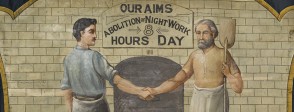Show students the side of the banner in English and ask them to decode the imagery and slogans on it. Who are the two men shaking hands and what does that symbolise? Can students explain what the banner was trying to convey? Who made it? Who was intended to see it? How would it have been used, do they think? Why would people decide to buy bread with the union label? How good an idea do they think it was to use the union label strategy?
Show students the reverse of the banner and the typewriter from For the classroom. What language is the reverse of the banner printed in? What language does the typewriter type in? Why do students think this was needed? What does it tell them about the nature of the Jewish community in East London in this period?
What were the aims of the London Jewish Bakers’ Union as set out on the banner? Do they seem unreasonable to students? Ask them to research the aims of some of the other unions in the early 20th century and what the rights of workers are today. Why was there a need for a union configured on a religious basis? There were many more Jewish unions in the early 20th century – students might explore why these have all now disappeared?
Divide your class into groups to carry out three related enquiries: 1) a large scale overview of the history of Jewish presence and immigration to Britain from the 1600s to 1925; 2) the reasons for and destinations of the emigration of Jews from Russia following the assassination of Tsar Alexander II from 1881 to 1925; 3) the immigration into the East End of London from 1881-1905. Consider how each enquiry complements the others and examine how the smaller enquiries fit into the larger. Discuss the experience of these three enquiries – how did they differ from each other?
Print out and distribute images of the objects in A bigger picture. Ask students to put them into what they think is chronological order. Ask students to do some research to refine their order and to flesh out each object a little. Use the objects as anchor points in a timeline of the history of the labour movement from the early 1800s to the present. Provide the students with a number of other events or moments of significance in labour history and after discussion, invite the students to keep or reject the original anchor points. How has the nature of campaigning changed over the decades? Look at some of the labour disputes of the 1970s and 1980s and how they inform us about the changes in the nature of employment and unions in the later 1900s – the Grunwick Dispute (1976-1978) involving East African Asian women workers and the Miners’ Strike (1984-5) might be good examples to compare.
Who caused the General Strike of 1926?
Introduce the General Strike of 1926 very briefly then give out copies of the two cartoons in For the classroom and ask the students to consider who these cartoons seem to indicate were to blame for the strike. Use information contained from books and website to make sets of cards indicating events, policies, actions or attitudes that may have contributed to the Strike. Ask students to group the cards based on the sides that emerged form discussion of the cartoons. Where do they think the causes lie having seen this information? Does this tally with the stance taken by the cartoons? Broaden the enquiry introducing other players such as the media and left-wing union leaders.
Why did the Labour Party have to wait until 1945 before winning an election outright?
The 1920s saw the rise of the Labour Party as the main opposition to the Conservatives. This enquiry could take a number of factors and consider the extent to which each might have helped or hindered Labour’s election prospects prior to its victory following World War II. The factors might include: the extension of voting rights to women over 21; the first Labour government of 1924 and why it fell; the impact of the 1924 general election on the Liberals; the General Strike and fear of the Russian Revolution and European immigrants; extreme right-wing politics in Europe and in Britain in the 1930s.


